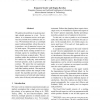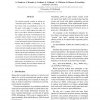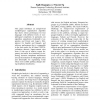NAACL
2007
14 years 1 months ago
2007
We address the problem of analyzing multiple related opinions in a text. For instance, in a restaurant review such opinions may include food, ambience and service. We formulate th...
NAACL
2007
14 years 1 months ago
2007
The task of identifying synonymous relations and objects, or Synonym Resolution (SR), is critical for high-quality information extraction. The bulk of previous SR work assumed str...
NAACL
2007
14 years 1 months ago
2007
Currently there are several approaches to machine translation (MT) based on different paradigms; e.g., phrasal, hierarchical and syntax-based. These three approaches yield similar...
NAACL
2007
14 years 1 months ago
2007
The immense prosodic variation of natural conversational speech makes it challenging to predict which words are prosodically prominent in this genre. In this paper, we examine a n...
NAACL
2007
14 years 1 months ago
2007
We study the use of rich syntax-based statistical models for generating grammatical case for the purpose of machine translation from a language which does not indicate case explic...
NAACL
2007
14 years 1 months ago
2007
We propose a novel HMM-based framework to accurately transliterate unseen named entities. The framework leverages features in letteralignment and letter n-gram pairs learned from ...
NAACL
2007
14 years 1 months ago
2007
NAACL
2007
14 years 1 months ago
2007
A novel random text generation model is introduced. Unlike in previous random text models, that mainly aim at producing a Zipfian distribution of word frequencies, our model also ...
NAACL
2007
14 years 1 months ago
2007
This paper explores the potential for annotating and enriching data for low-density languages via the alignment and projection of syntactic structure from parsed data for resource...
NAACL
2007
14 years 1 months ago
2007
This paper introduces an unsupervised morphological segmentation algorithm that shows robust performance for four languages with different levels of morphological complexity. In p...







